Practical Application of Renewable Energy Technology Report
VerifiedAdded on 2023/01/17
|32
|6094
|22
Report
AI Summary
This report delves into the practical application of renewable energy technologies, focusing on solar, wind, and hydropower. It begins with schematic diagrams of each system, providing a foundational understanding of their operation. The report then analyzes the adoption rates of wind and solar energy, discussing barriers such as high capital costs for wind energy and market competition. It also explores the advantages of solar energy's relatively lower installation costs. The second part of the report provides a technical analysis of wind and solar power generation, including the processes of energy conversion, transmission, and distribution. The report then examines the benefits of renewable energy for residents of Polperro, emphasizing reduced global warming, improved public health, lower electricity bills, and a reliable energy supply. Finally, it considers combinations of renewable energy sources, highlighting the potential for efficient and reliable energy generation in the region.
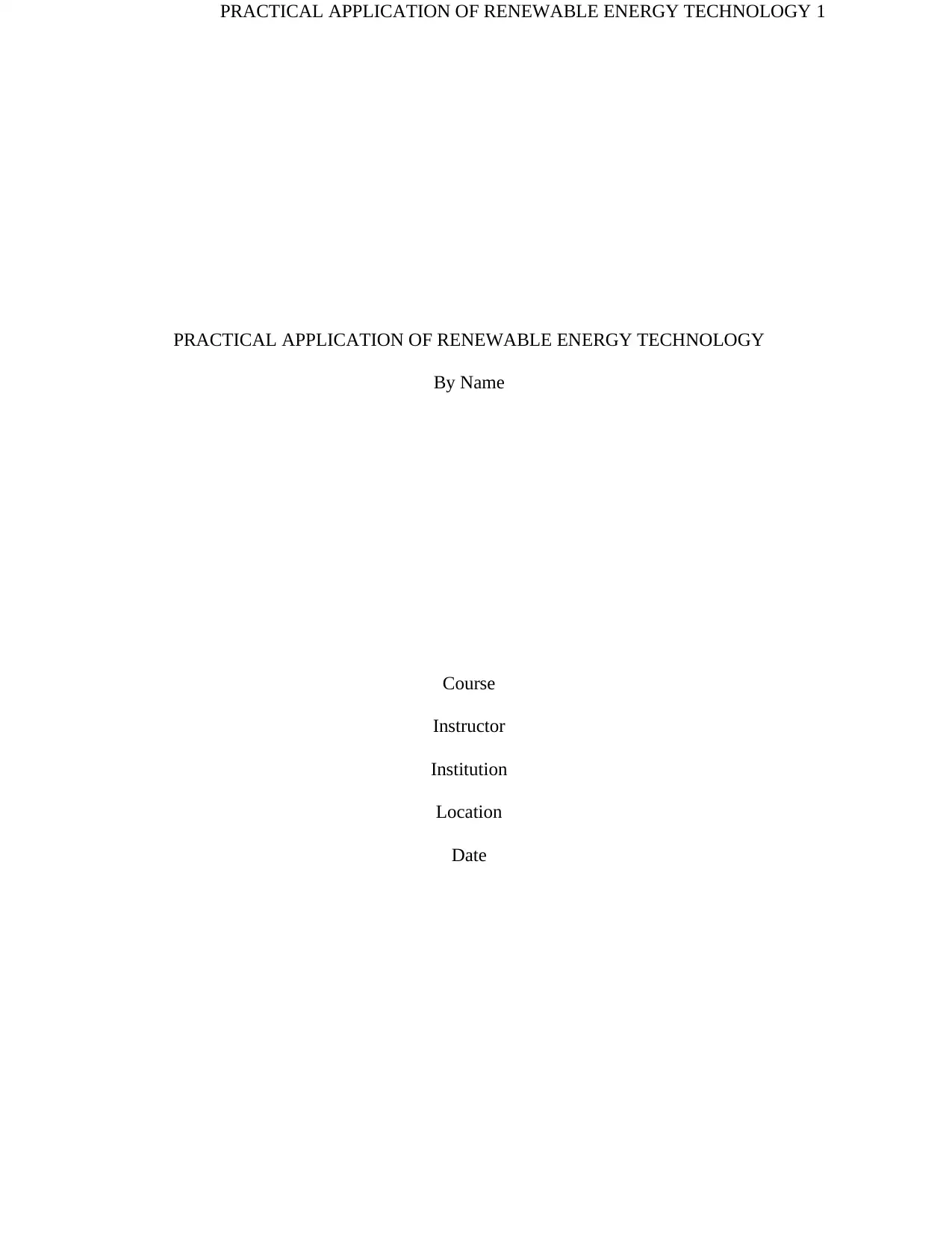
PRACTICAL APPLICATION OF RENEWABLE ENERGY TECHNOLOGY 1
PRACTICAL APPLICATION OF RENEWABLE ENERGY TECHNOLOGY
By Name
Course
Instructor
Institution
Location
Date
PRACTICAL APPLICATION OF RENEWABLE ENERGY TECHNOLOGY
By Name
Course
Instructor
Institution
Location
Date
Paraphrase This Document
Need a fresh take? Get an instant paraphrase of this document with our AI Paraphraser
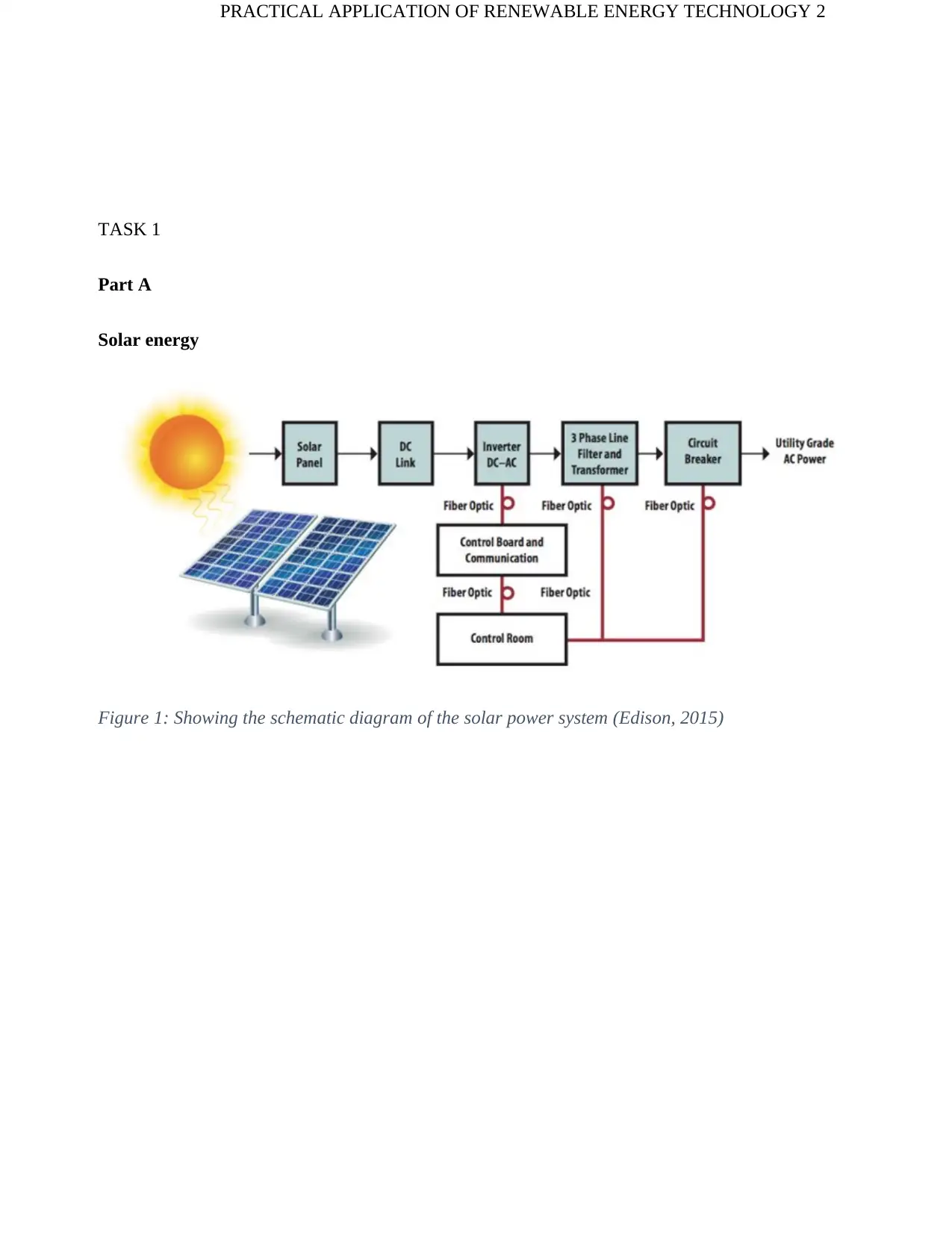
PRACTICAL APPLICATION OF RENEWABLE ENERGY TECHNOLOGY 2
TASK 1
Part A
Solar energy
Figure 1: Showing the schematic diagram of the solar power system (Edison, 2015)
TASK 1
Part A
Solar energy
Figure 1: Showing the schematic diagram of the solar power system (Edison, 2015)
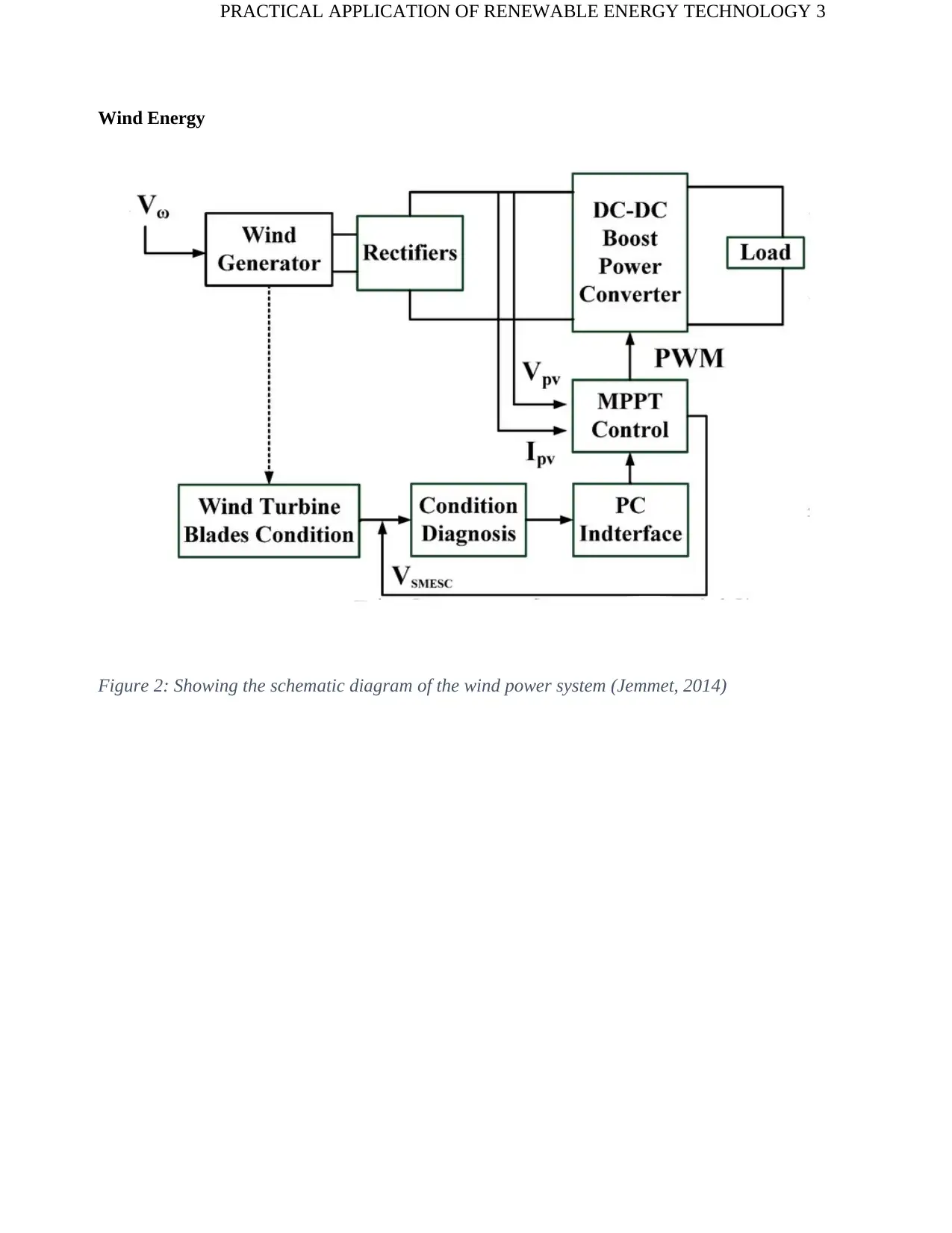
PRACTICAL APPLICATION OF RENEWABLE ENERGY TECHNOLOGY 3
Wind Energy
Figure 2: Showing the schematic diagram of the wind power system (Jemmet, 2014)
Wind Energy
Figure 2: Showing the schematic diagram of the wind power system (Jemmet, 2014)
⊘ This is a preview!⊘
Do you want full access?
Subscribe today to unlock all pages.

Trusted by 1+ million students worldwide
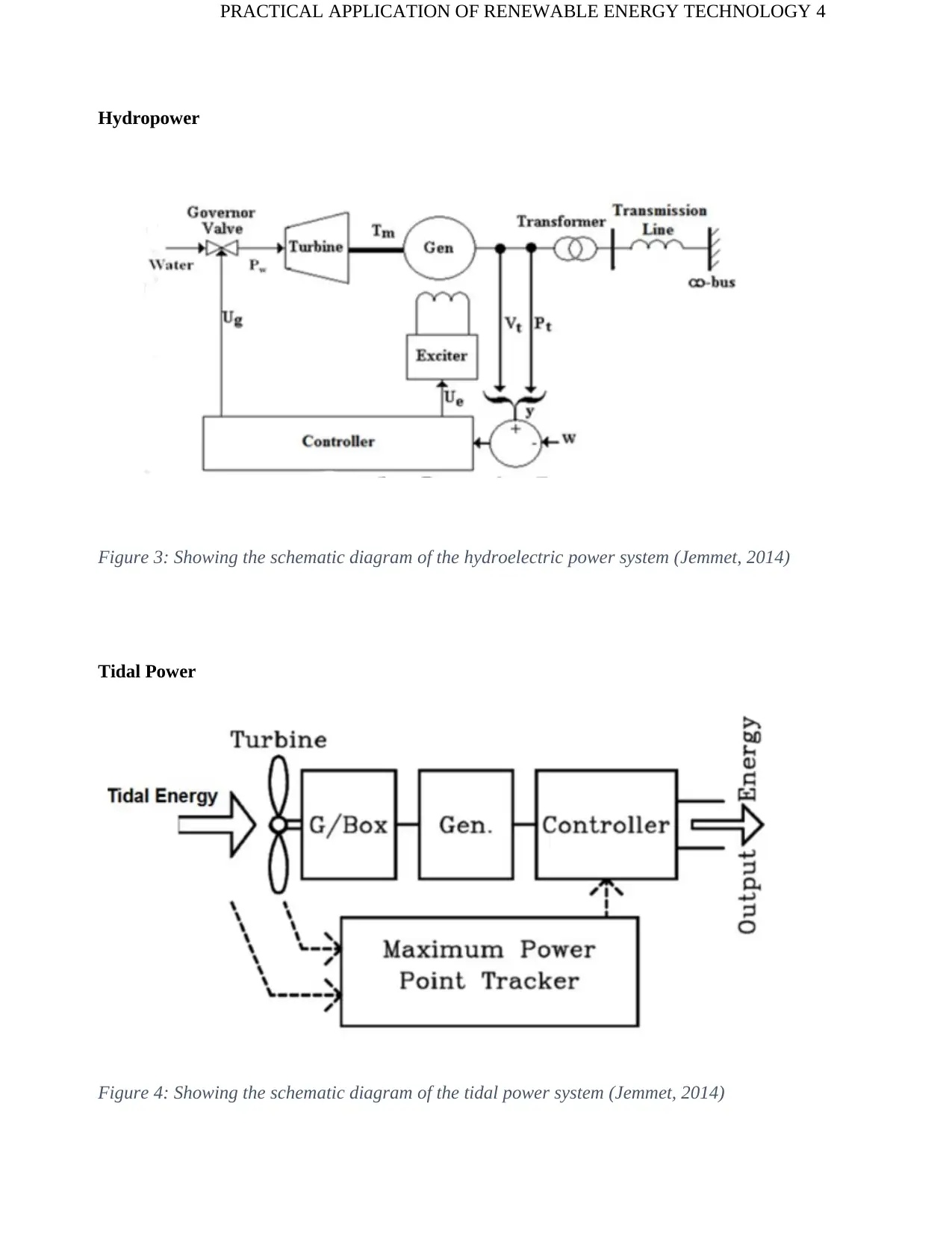
PRACTICAL APPLICATION OF RENEWABLE ENERGY TECHNOLOGY 4
Hydropower
Figure 3: Showing the schematic diagram of the hydroelectric power system (Jemmet, 2014)
Tidal Power
Figure 4: Showing the schematic diagram of the tidal power system (Jemmet, 2014)
Hydropower
Figure 3: Showing the schematic diagram of the hydroelectric power system (Jemmet, 2014)
Tidal Power
Figure 4: Showing the schematic diagram of the tidal power system (Jemmet, 2014)
Paraphrase This Document
Need a fresh take? Get an instant paraphrase of this document with our AI Paraphraser
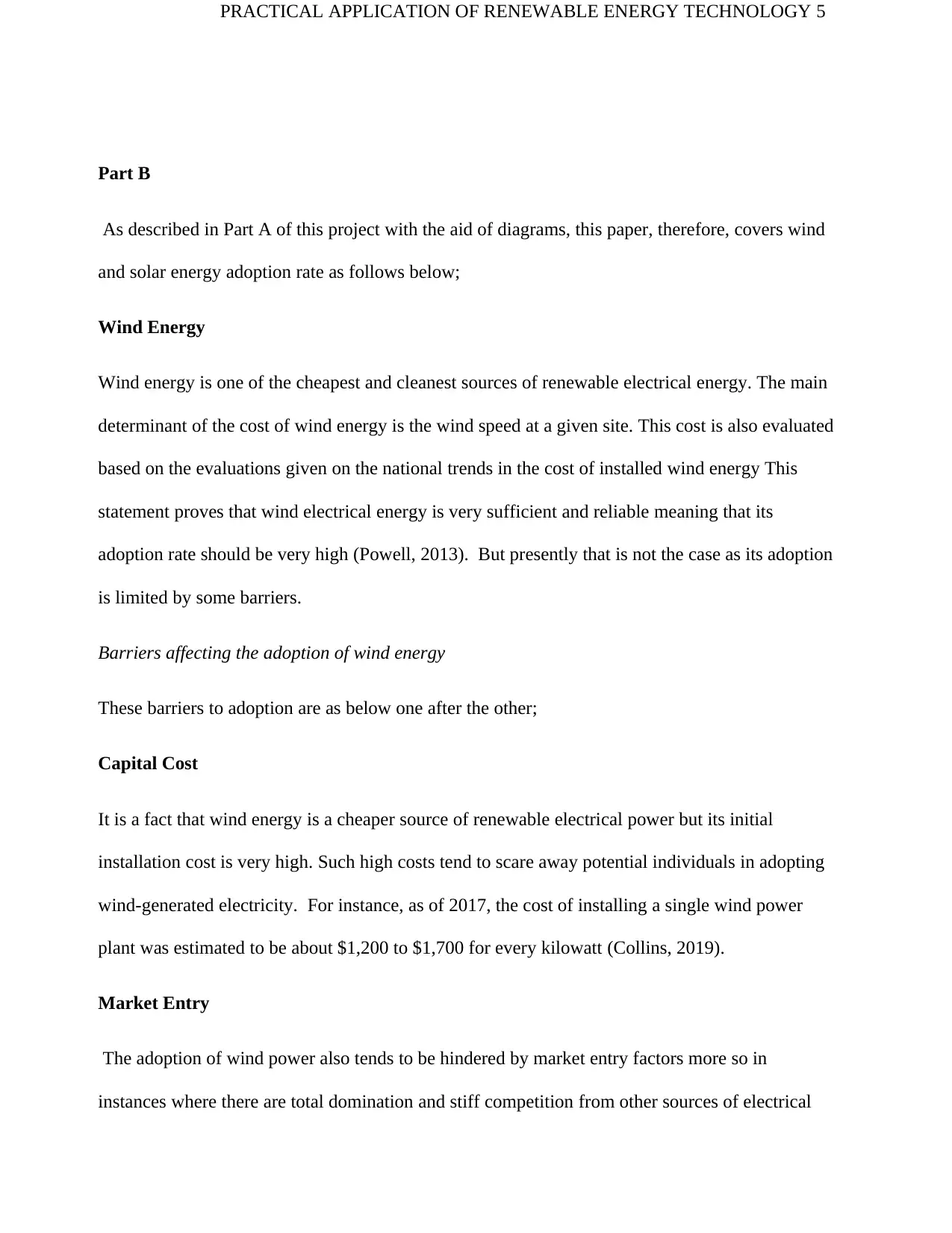
PRACTICAL APPLICATION OF RENEWABLE ENERGY TECHNOLOGY 5
Part B
As described in Part A of this project with the aid of diagrams, this paper, therefore, covers wind
and solar energy adoption rate as follows below;
Wind Energy
Wind energy is one of the cheapest and cleanest sources of renewable electrical energy. The main
determinant of the cost of wind energy is the wind speed at a given site. This cost is also evaluated
based on the evaluations given on the national trends in the cost of installed wind energy This
statement proves that wind electrical energy is very sufficient and reliable meaning that its
adoption rate should be very high (Powell, 2013). But presently that is not the case as its adoption
is limited by some barriers.
Barriers affecting the adoption of wind energy
These barriers to adoption are as below one after the other;
Capital Cost
It is a fact that wind energy is a cheaper source of renewable electrical power but its initial
installation cost is very high. Such high costs tend to scare away potential individuals in adopting
wind-generated electricity. For instance, as of 2017, the cost of installing a single wind power
plant was estimated to be about $1,200 to $1,700 for every kilowatt (Collins, 2019).
Market Entry
The adoption of wind power also tends to be hindered by market entry factors more so in
instances where there are total domination and stiff competition from other sources of electrical
Part B
As described in Part A of this project with the aid of diagrams, this paper, therefore, covers wind
and solar energy adoption rate as follows below;
Wind Energy
Wind energy is one of the cheapest and cleanest sources of renewable electrical energy. The main
determinant of the cost of wind energy is the wind speed at a given site. This cost is also evaluated
based on the evaluations given on the national trends in the cost of installed wind energy This
statement proves that wind electrical energy is very sufficient and reliable meaning that its
adoption rate should be very high (Powell, 2013). But presently that is not the case as its adoption
is limited by some barriers.
Barriers affecting the adoption of wind energy
These barriers to adoption are as below one after the other;
Capital Cost
It is a fact that wind energy is a cheaper source of renewable electrical power but its initial
installation cost is very high. Such high costs tend to scare away potential individuals in adopting
wind-generated electricity. For instance, as of 2017, the cost of installing a single wind power
plant was estimated to be about $1,200 to $1,700 for every kilowatt (Collins, 2019).
Market Entry
The adoption of wind power also tends to be hindered by market entry factors more so in
instances where there are total domination and stiff competition from other sources of electrical
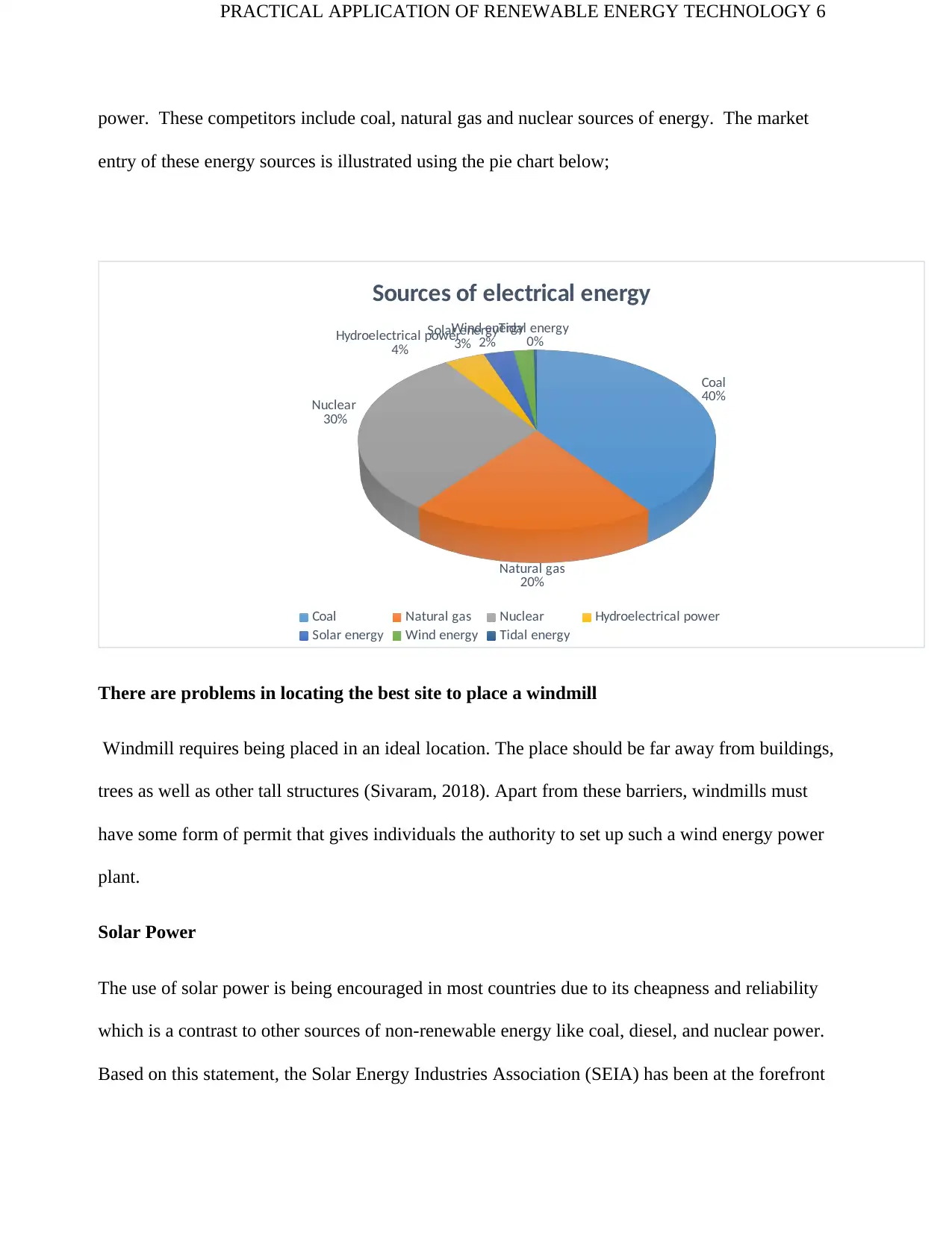
PRACTICAL APPLICATION OF RENEWABLE ENERGY TECHNOLOGY 6
power. These competitors include coal, natural gas and nuclear sources of energy. The market
entry of these energy sources is illustrated using the pie chart below;
Coal
40%
Natural gas
20%
Nuclear
30%
Hydroelectrical power
4%
Solar energy
3%
Wind energy
2%
Tidal energy
0%
Sources of electrical energy
Coal Natural gas Nuclear Hydroelectrical power
Solar energy Wind energy Tidal energy
There are problems in locating the best site to place a windmill
Windmill requires being placed in an ideal location. The place should be far away from buildings,
trees as well as other tall structures (Sivaram, 2018). Apart from these barriers, windmills must
have some form of permit that gives individuals the authority to set up such a wind energy power
plant.
Solar Power
The use of solar power is being encouraged in most countries due to its cheapness and reliability
which is a contrast to other sources of non-renewable energy like coal, diesel, and nuclear power.
Based on this statement, the Solar Energy Industries Association (SEIA) has been at the forefront
power. These competitors include coal, natural gas and nuclear sources of energy. The market
entry of these energy sources is illustrated using the pie chart below;
Coal
40%
Natural gas
20%
Nuclear
30%
Hydroelectrical power
4%
Solar energy
3%
Wind energy
2%
Tidal energy
0%
Sources of electrical energy
Coal Natural gas Nuclear Hydroelectrical power
Solar energy Wind energy Tidal energy
There are problems in locating the best site to place a windmill
Windmill requires being placed in an ideal location. The place should be far away from buildings,
trees as well as other tall structures (Sivaram, 2018). Apart from these barriers, windmills must
have some form of permit that gives individuals the authority to set up such a wind energy power
plant.
Solar Power
The use of solar power is being encouraged in most countries due to its cheapness and reliability
which is a contrast to other sources of non-renewable energy like coal, diesel, and nuclear power.
Based on this statement, the Solar Energy Industries Association (SEIA) has been at the forefront
⊘ This is a preview!⊘
Do you want full access?
Subscribe today to unlock all pages.

Trusted by 1+ million students worldwide
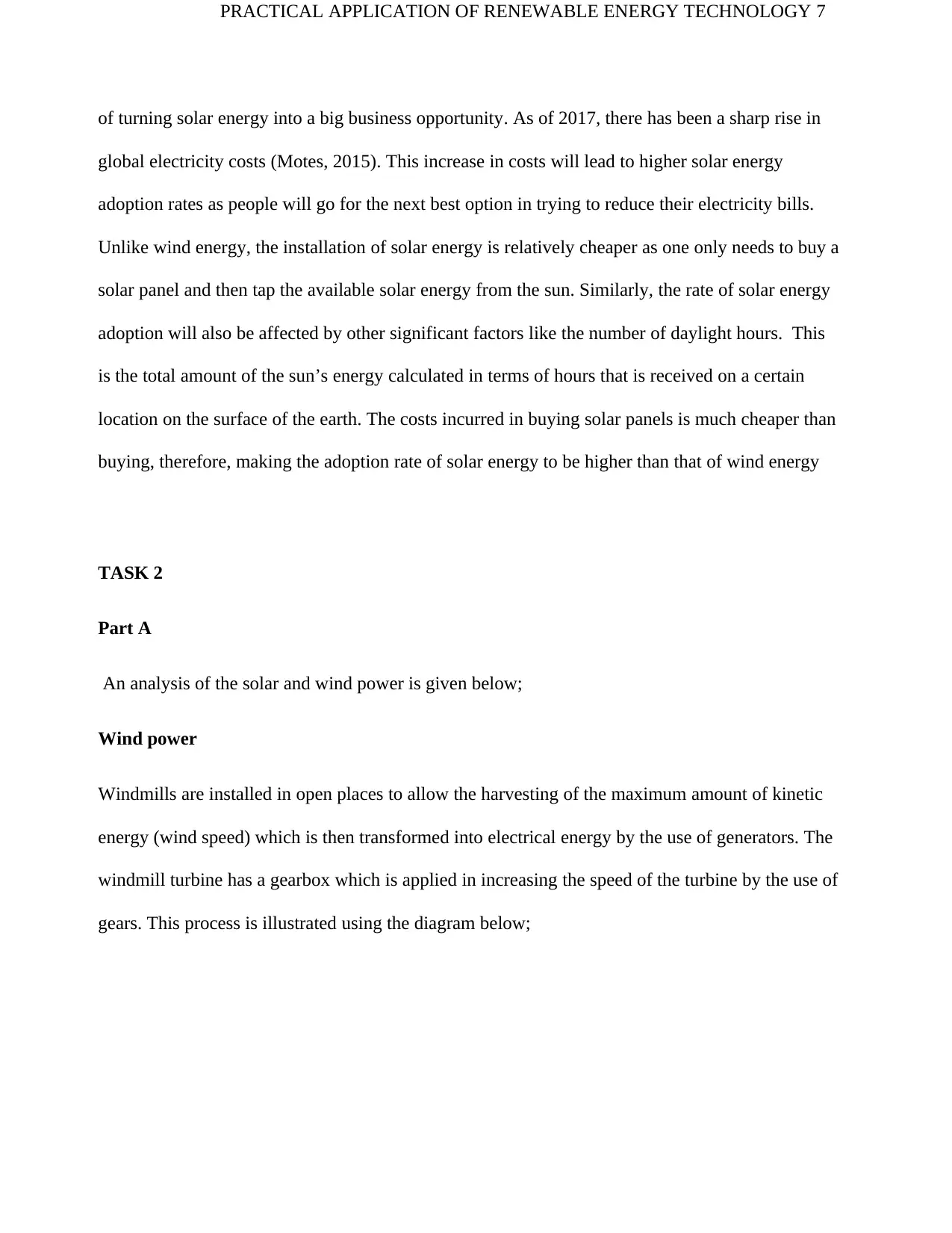
PRACTICAL APPLICATION OF RENEWABLE ENERGY TECHNOLOGY 7
of turning solar energy into a big business opportunity. As of 2017, there has been a sharp rise in
global electricity costs (Motes, 2015). This increase in costs will lead to higher solar energy
adoption rates as people will go for the next best option in trying to reduce their electricity bills.
Unlike wind energy, the installation of solar energy is relatively cheaper as one only needs to buy a
solar panel and then tap the available solar energy from the sun. Similarly, the rate of solar energy
adoption will also be affected by other significant factors like the number of daylight hours. This
is the total amount of the sun’s energy calculated in terms of hours that is received on a certain
location on the surface of the earth. The costs incurred in buying solar panels is much cheaper than
buying, therefore, making the adoption rate of solar energy to be higher than that of wind energy
TASK 2
Part A
An analysis of the solar and wind power is given below;
Wind power
Windmills are installed in open places to allow the harvesting of the maximum amount of kinetic
energy (wind speed) which is then transformed into electrical energy by the use of generators. The
windmill turbine has a gearbox which is applied in increasing the speed of the turbine by the use of
gears. This process is illustrated using the diagram below;
of turning solar energy into a big business opportunity. As of 2017, there has been a sharp rise in
global electricity costs (Motes, 2015). This increase in costs will lead to higher solar energy
adoption rates as people will go for the next best option in trying to reduce their electricity bills.
Unlike wind energy, the installation of solar energy is relatively cheaper as one only needs to buy a
solar panel and then tap the available solar energy from the sun. Similarly, the rate of solar energy
adoption will also be affected by other significant factors like the number of daylight hours. This
is the total amount of the sun’s energy calculated in terms of hours that is received on a certain
location on the surface of the earth. The costs incurred in buying solar panels is much cheaper than
buying, therefore, making the adoption rate of solar energy to be higher than that of wind energy
TASK 2
Part A
An analysis of the solar and wind power is given below;
Wind power
Windmills are installed in open places to allow the harvesting of the maximum amount of kinetic
energy (wind speed) which is then transformed into electrical energy by the use of generators. The
windmill turbine has a gearbox which is applied in increasing the speed of the turbine by the use of
gears. This process is illustrated using the diagram below;
Paraphrase This Document
Need a fresh take? Get an instant paraphrase of this document with our AI Paraphraser
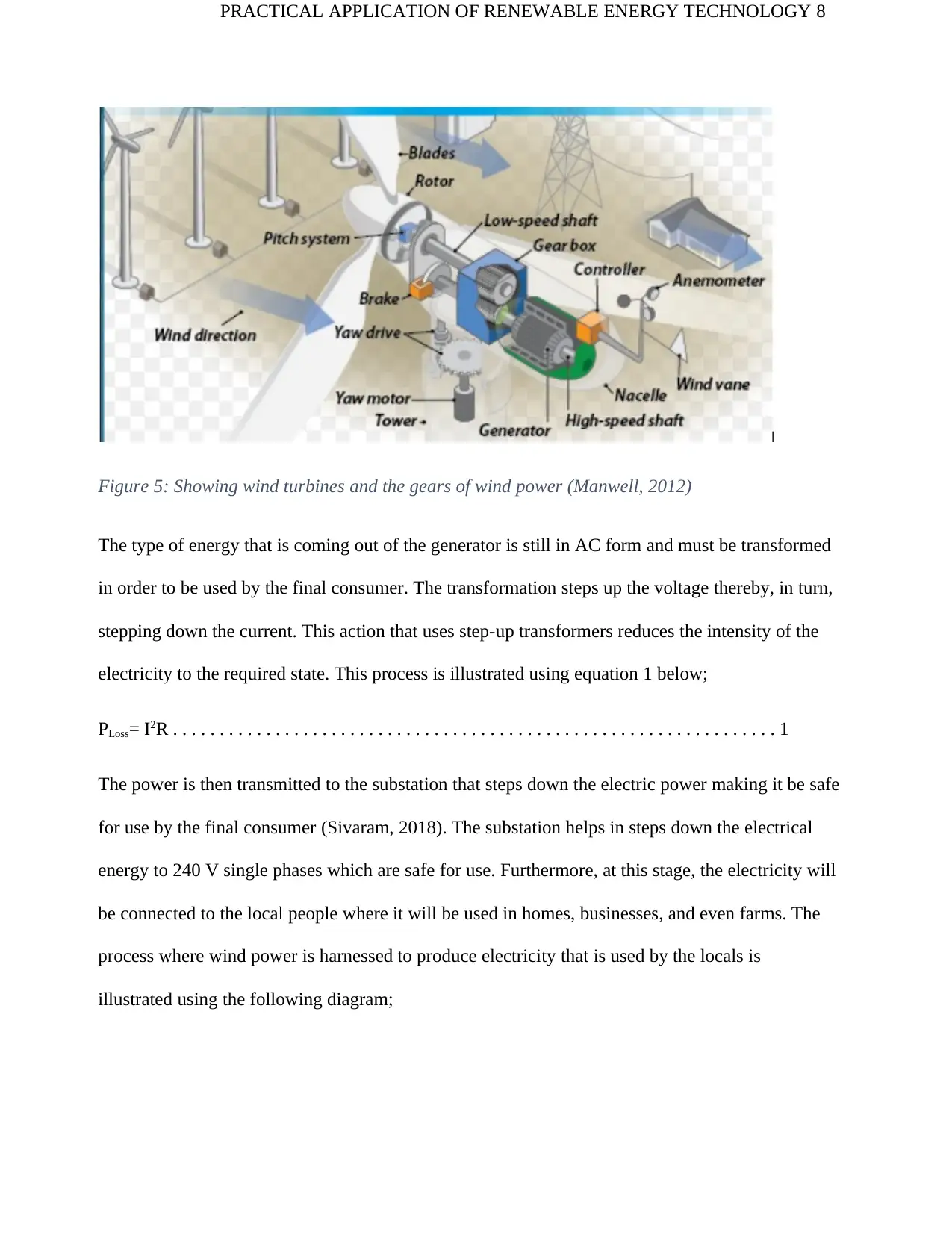
PRACTICAL APPLICATION OF RENEWABLE ENERGY TECHNOLOGY 8
Figure 5: Showing wind turbines and the gears of wind power (Manwell, 2012)
The type of energy that is coming out of the generator is still in AC form and must be transformed
in order to be used by the final consumer. The transformation steps up the voltage thereby, in turn,
stepping down the current. This action that uses step-up transformers reduces the intensity of the
electricity to the required state. This process is illustrated using equation 1 below;
PLoss= I2R . . . . . . . . . . . . . . . . . . . . . . . . . . . . . . . . . . . . . . . . . . . . . . . . . . . . . . . . . . . . . . . . . 1
The power is then transmitted to the substation that steps down the electric power making it be safe
for use by the final consumer (Sivaram, 2018). The substation helps in steps down the electrical
energy to 240 V single phases which are safe for use. Furthermore, at this stage, the electricity will
be connected to the local people where it will be used in homes, businesses, and even farms. The
process where wind power is harnessed to produce electricity that is used by the locals is
illustrated using the following diagram;
Figure 5: Showing wind turbines and the gears of wind power (Manwell, 2012)
The type of energy that is coming out of the generator is still in AC form and must be transformed
in order to be used by the final consumer. The transformation steps up the voltage thereby, in turn,
stepping down the current. This action that uses step-up transformers reduces the intensity of the
electricity to the required state. This process is illustrated using equation 1 below;
PLoss= I2R . . . . . . . . . . . . . . . . . . . . . . . . . . . . . . . . . . . . . . . . . . . . . . . . . . . . . . . . . . . . . . . . . 1
The power is then transmitted to the substation that steps down the electric power making it be safe
for use by the final consumer (Sivaram, 2018). The substation helps in steps down the electrical
energy to 240 V single phases which are safe for use. Furthermore, at this stage, the electricity will
be connected to the local people where it will be used in homes, businesses, and even farms. The
process where wind power is harnessed to produce electricity that is used by the locals is
illustrated using the following diagram;
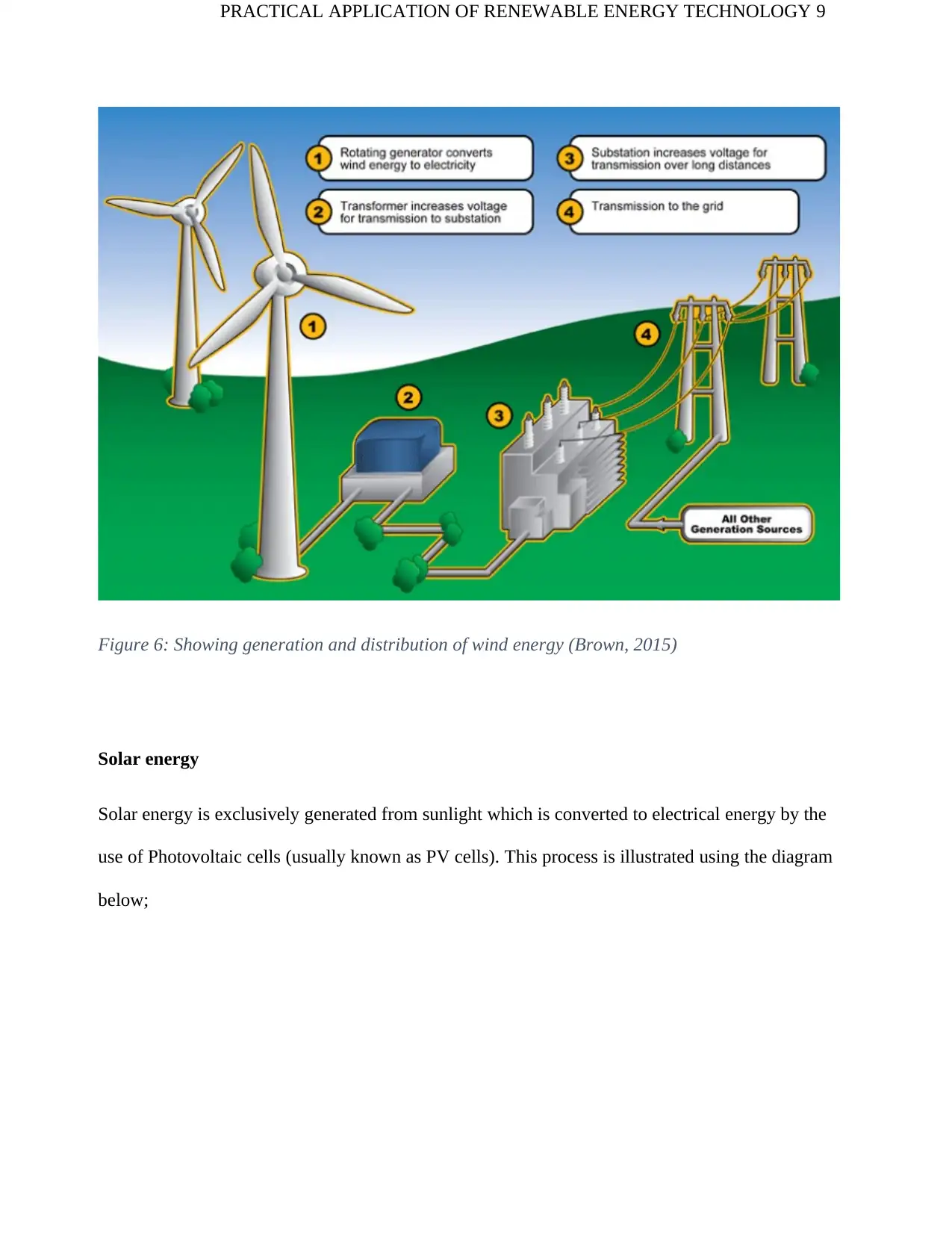
PRACTICAL APPLICATION OF RENEWABLE ENERGY TECHNOLOGY 9
Figure 6: Showing generation and distribution of wind energy (Brown, 2015)
Solar energy
Solar energy is exclusively generated from sunlight which is converted to electrical energy by the
use of Photovoltaic cells (usually known as PV cells). This process is illustrated using the diagram
below;
Figure 6: Showing generation and distribution of wind energy (Brown, 2015)
Solar energy
Solar energy is exclusively generated from sunlight which is converted to electrical energy by the
use of Photovoltaic cells (usually known as PV cells). This process is illustrated using the diagram
below;
⊘ This is a preview!⊘
Do you want full access?
Subscribe today to unlock all pages.

Trusted by 1+ million students worldwide
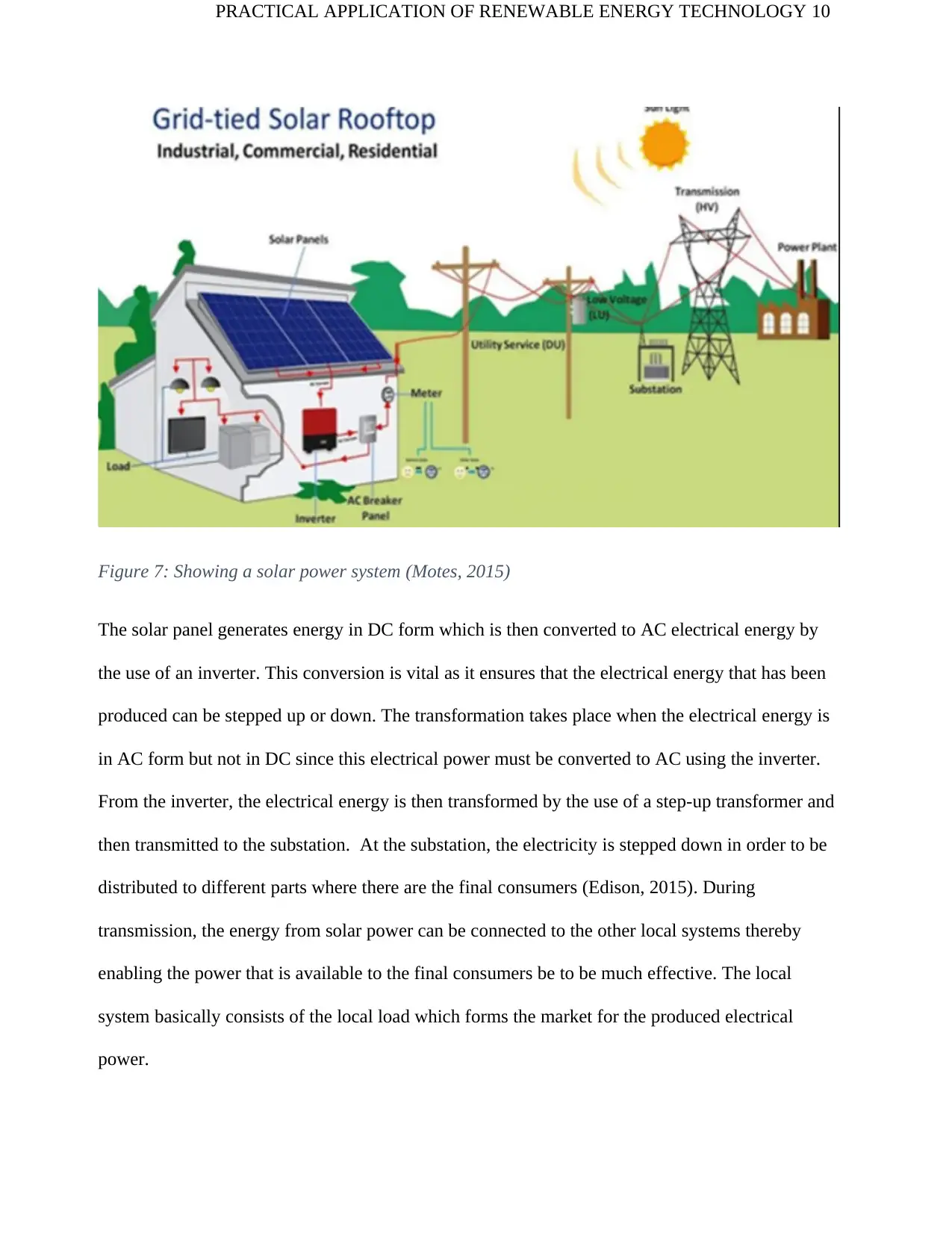
PRACTICAL APPLICATION OF RENEWABLE ENERGY TECHNOLOGY 10
Figure 7: Showing a solar power system (Motes, 2015)
The solar panel generates energy in DC form which is then converted to AC electrical energy by
the use of an inverter. This conversion is vital as it ensures that the electrical energy that has been
produced can be stepped up or down. The transformation takes place when the electrical energy is
in AC form but not in DC since this electrical power must be converted to AC using the inverter.
From the inverter, the electrical energy is then transformed by the use of a step-up transformer and
then transmitted to the substation. At the substation, the electricity is stepped down in order to be
distributed to different parts where there are the final consumers (Edison, 2015). During
transmission, the energy from solar power can be connected to the other local systems thereby
enabling the power that is available to the final consumers be to be much effective. The local
system basically consists of the local load which forms the market for the produced electrical
power.
Figure 7: Showing a solar power system (Motes, 2015)
The solar panel generates energy in DC form which is then converted to AC electrical energy by
the use of an inverter. This conversion is vital as it ensures that the electrical energy that has been
produced can be stepped up or down. The transformation takes place when the electrical energy is
in AC form but not in DC since this electrical power must be converted to AC using the inverter.
From the inverter, the electrical energy is then transformed by the use of a step-up transformer and
then transmitted to the substation. At the substation, the electricity is stepped down in order to be
distributed to different parts where there are the final consumers (Edison, 2015). During
transmission, the energy from solar power can be connected to the other local systems thereby
enabling the power that is available to the final consumers be to be much effective. The local
system basically consists of the local load which forms the market for the produced electrical
power.
Paraphrase This Document
Need a fresh take? Get an instant paraphrase of this document with our AI Paraphraser
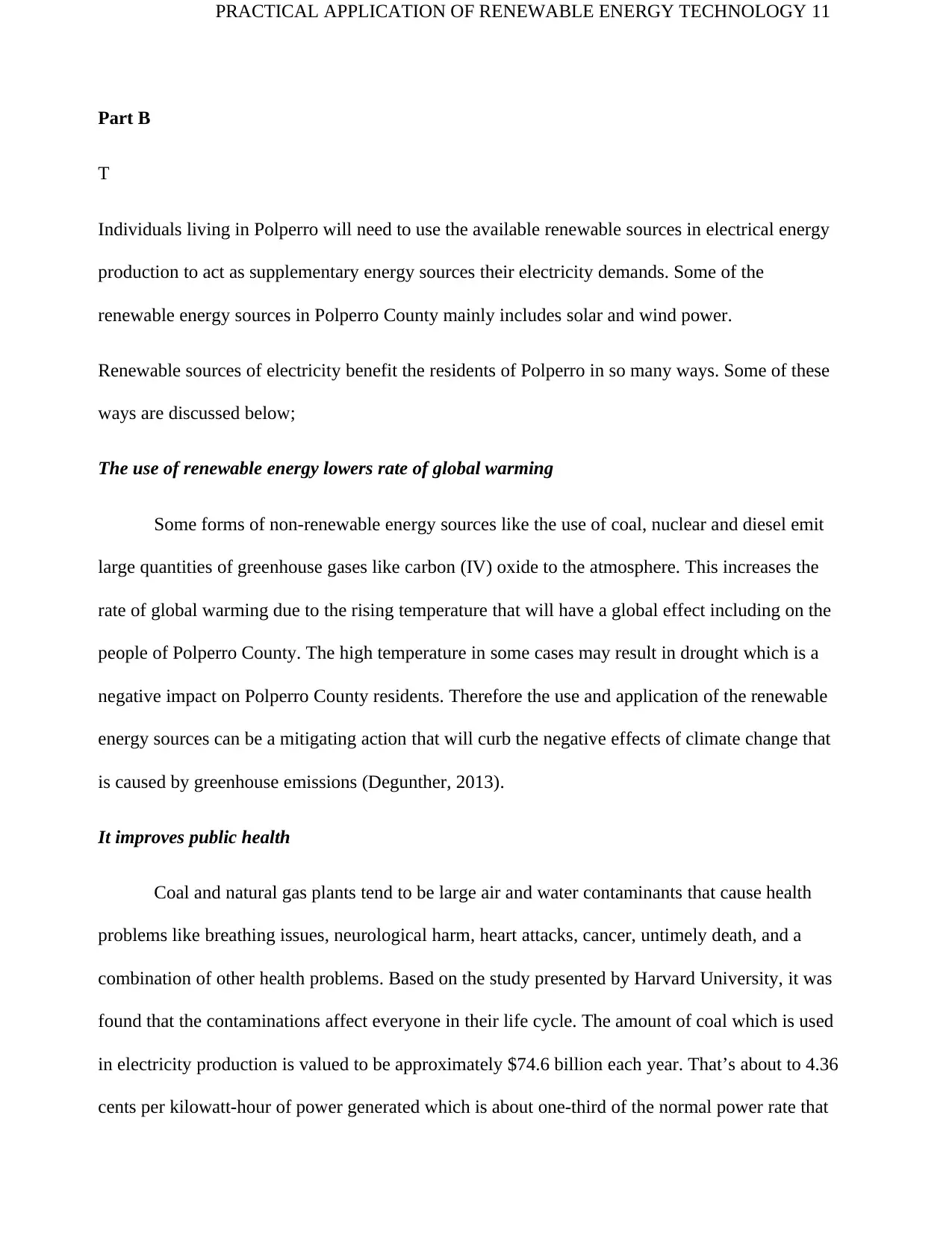
PRACTICAL APPLICATION OF RENEWABLE ENERGY TECHNOLOGY 11
Part B
T
Individuals living in Polperro will need to use the available renewable sources in electrical energy
production to act as supplementary energy sources their electricity demands. Some of the
renewable energy sources in Polperro County mainly includes solar and wind power.
Renewable sources of electricity benefit the residents of Polperro in so many ways. Some of these
ways are discussed below;
The use of renewable energy lowers rate of global warming
Some forms of non-renewable energy sources like the use of coal, nuclear and diesel emit
large quantities of greenhouse gases like carbon (IV) oxide to the atmosphere. This increases the
rate of global warming due to the rising temperature that will have a global effect including on the
people of Polperro County. The high temperature in some cases may result in drought which is a
negative impact on Polperro County residents. Therefore the use and application of the renewable
energy sources can be a mitigating action that will curb the negative effects of climate change that
is caused by greenhouse emissions (Degunther, 2013).
It improves public health
Coal and natural gas plants tend to be large air and water contaminants that cause health
problems like breathing issues, neurological harm, heart attacks, cancer, untimely death, and a
combination of other health problems. Based on the study presented by Harvard University, it was
found that the contaminations affect everyone in their life cycle. The amount of coal which is used
in electricity production is valued to be approximately $74.6 billion each year. That’s about to 4.36
cents per kilowatt-hour of power generated which is about one-third of the normal power rate that
Part B
T
Individuals living in Polperro will need to use the available renewable sources in electrical energy
production to act as supplementary energy sources their electricity demands. Some of the
renewable energy sources in Polperro County mainly includes solar and wind power.
Renewable sources of electricity benefit the residents of Polperro in so many ways. Some of these
ways are discussed below;
The use of renewable energy lowers rate of global warming
Some forms of non-renewable energy sources like the use of coal, nuclear and diesel emit
large quantities of greenhouse gases like carbon (IV) oxide to the atmosphere. This increases the
rate of global warming due to the rising temperature that will have a global effect including on the
people of Polperro County. The high temperature in some cases may result in drought which is a
negative impact on Polperro County residents. Therefore the use and application of the renewable
energy sources can be a mitigating action that will curb the negative effects of climate change that
is caused by greenhouse emissions (Degunther, 2013).
It improves public health
Coal and natural gas plants tend to be large air and water contaminants that cause health
problems like breathing issues, neurological harm, heart attacks, cancer, untimely death, and a
combination of other health problems. Based on the study presented by Harvard University, it was
found that the contaminations affect everyone in their life cycle. The amount of coal which is used
in electricity production is valued to be approximately $74.6 billion each year. That’s about to 4.36
cents per kilowatt-hour of power generated which is about one-third of the normal power rate that
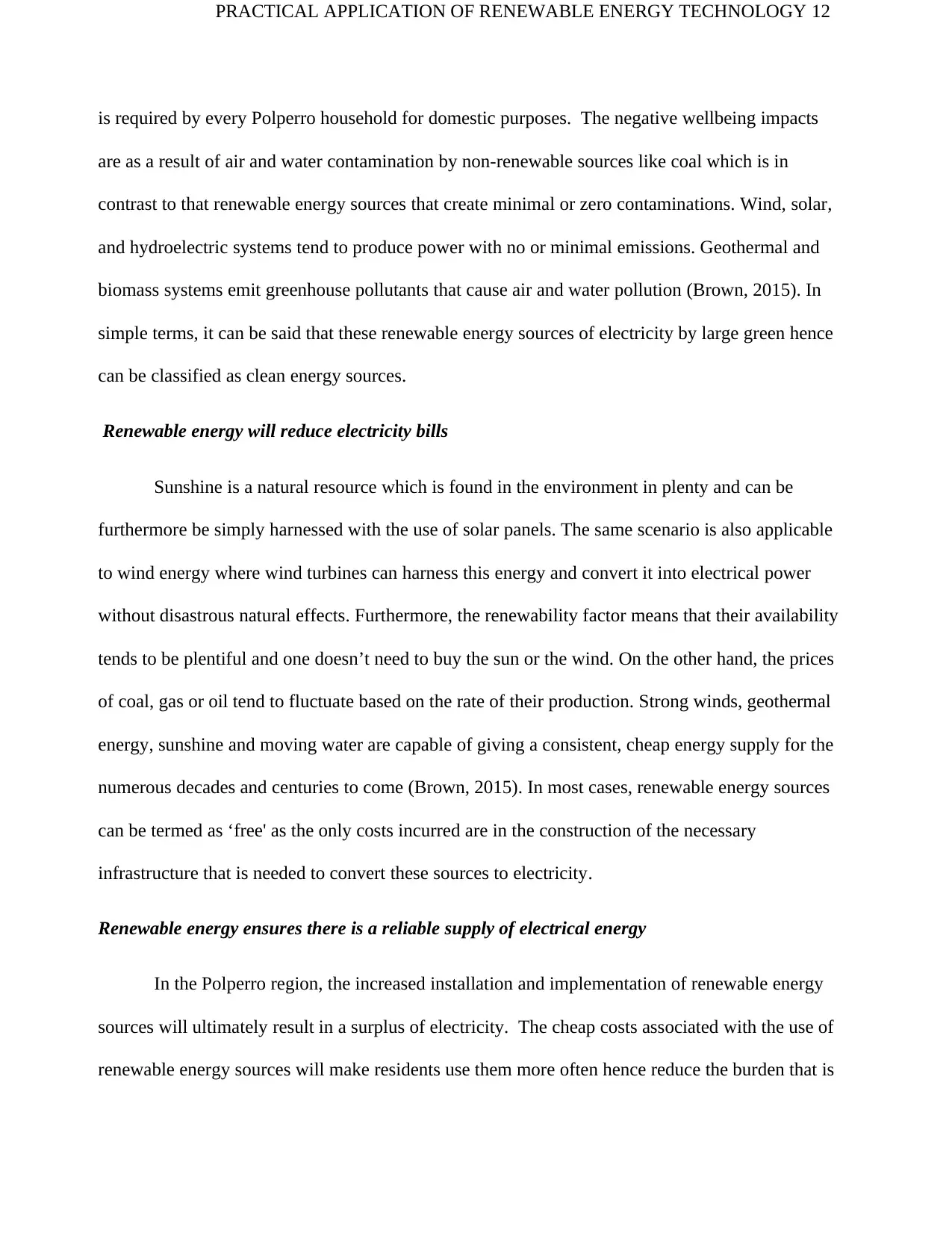
PRACTICAL APPLICATION OF RENEWABLE ENERGY TECHNOLOGY 12
is required by every Polperro household for domestic purposes. The negative wellbeing impacts
are as a result of air and water contamination by non-renewable sources like coal which is in
contrast to that renewable energy sources that create minimal or zero contaminations. Wind, solar,
and hydroelectric systems tend to produce power with no or minimal emissions. Geothermal and
biomass systems emit greenhouse pollutants that cause air and water pollution (Brown, 2015). In
simple terms, it can be said that these renewable energy sources of electricity by large green hence
can be classified as clean energy sources.
Renewable energy will reduce electricity bills
Sunshine is a natural resource which is found in the environment in plenty and can be
furthermore be simply harnessed with the use of solar panels. The same scenario is also applicable
to wind energy where wind turbines can harness this energy and convert it into electrical power
without disastrous natural effects. Furthermore, the renewability factor means that their availability
tends to be plentiful and one doesn’t need to buy the sun or the wind. On the other hand, the prices
of coal, gas or oil tend to fluctuate based on the rate of their production. Strong winds, geothermal
energy, sunshine and moving water are capable of giving a consistent, cheap energy supply for the
numerous decades and centuries to come (Brown, 2015). In most cases, renewable energy sources
can be termed as ‘free' as the only costs incurred are in the construction of the necessary
infrastructure that is needed to convert these sources to electricity.
Renewable energy ensures there is a reliable supply of electrical energy
In the Polperro region, the increased installation and implementation of renewable energy
sources will ultimately result in a surplus of electricity. The cheap costs associated with the use of
renewable energy sources will make residents use them more often hence reduce the burden that is
is required by every Polperro household for domestic purposes. The negative wellbeing impacts
are as a result of air and water contamination by non-renewable sources like coal which is in
contrast to that renewable energy sources that create minimal or zero contaminations. Wind, solar,
and hydroelectric systems tend to produce power with no or minimal emissions. Geothermal and
biomass systems emit greenhouse pollutants that cause air and water pollution (Brown, 2015). In
simple terms, it can be said that these renewable energy sources of electricity by large green hence
can be classified as clean energy sources.
Renewable energy will reduce electricity bills
Sunshine is a natural resource which is found in the environment in plenty and can be
furthermore be simply harnessed with the use of solar panels. The same scenario is also applicable
to wind energy where wind turbines can harness this energy and convert it into electrical power
without disastrous natural effects. Furthermore, the renewability factor means that their availability
tends to be plentiful and one doesn’t need to buy the sun or the wind. On the other hand, the prices
of coal, gas or oil tend to fluctuate based on the rate of their production. Strong winds, geothermal
energy, sunshine and moving water are capable of giving a consistent, cheap energy supply for the
numerous decades and centuries to come (Brown, 2015). In most cases, renewable energy sources
can be termed as ‘free' as the only costs incurred are in the construction of the necessary
infrastructure that is needed to convert these sources to electricity.
Renewable energy ensures there is a reliable supply of electrical energy
In the Polperro region, the increased installation and implementation of renewable energy
sources will ultimately result in a surplus of electricity. The cheap costs associated with the use of
renewable energy sources will make residents use them more often hence reduce the burden that is
⊘ This is a preview!⊘
Do you want full access?
Subscribe today to unlock all pages.

Trusted by 1+ million students worldwide
1 out of 32
Related Documents
Your All-in-One AI-Powered Toolkit for Academic Success.
+13062052269
info@desklib.com
Available 24*7 on WhatsApp / Email
![[object Object]](/_next/static/media/star-bottom.7253800d.svg)
Unlock your academic potential
Copyright © 2020–2025 A2Z Services. All Rights Reserved. Developed and managed by ZUCOL.
